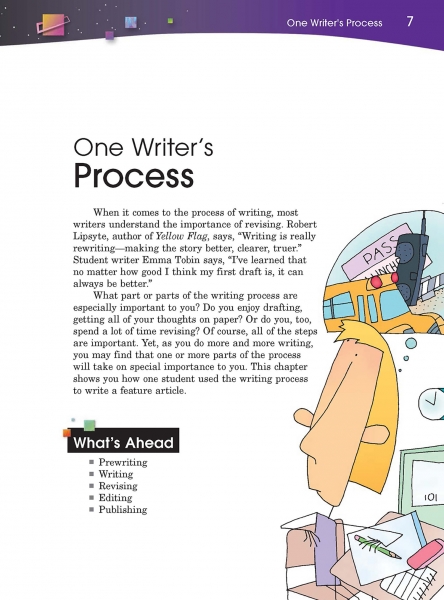Page 007 from

Start-Up Activity
“One Writer’s Process” shows students how much time and effort are required to produce a quality piece of writing. So we recommend that you introduce this chapter early on and that you revisit it at different points during the school year.
Display these quotations and have a volunteer explain what each one has to do with writing.
- “You can’t wait for inspiration. You have to go after it with a club.” —Jack London
- “Unfortunately, you learn from your mistakes. Unless you’re a genius I don’t see how you could do it right the first time.” —Lloyd Alexander
- “The real work comes in the rewriting stage.” —Virginia Hamilton
Then read aloud and discuss the introduction to the chapter. Ask for volunteers to share their thoughts about their writing habits: Are they quick or thorough planners? Do they try to get everything right in one draft? Do they have a hard time changing parts of their writing?
Think About It
“What is written without effort is in general read without pleasure.”
—Dr. Samuel Johnson

Start-Up Activity
“One Writer’s Process” shows students how much time and effort are required to produce a quality piece of writing. So we recommend that you introduce this chapter early on and that you revisit it at different points during the school year.
Display these quotations and have a volunteer explain what each one has to do with writing.
- “You can’t wait for inspiration. You have to go after it with a club.” —Jack London
- “Unfortunately, you learn from your mistakes. Unless you’re a genius I don’t see how you could do it right the first time.” —Lloyd Alexander
- “The real work comes in the rewriting stage.” —Virginia Hamilton
Then read aloud and discuss the introduction to the chapter. Ask for volunteers to share their thoughts about their writing habits: Are they quick or thorough planners? Do they try to get everything right in one draft? Do they have a hard time changing parts of their writing?
Think About It
“What is written without effort is in general read without pleasure.”
—Dr. Samuel Johnson



